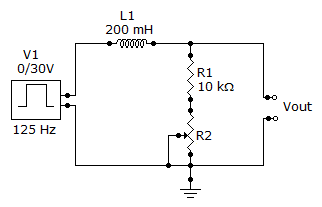Discussion
Home ‣ Electrical Engineering ‣ Time Response of Reactive Circuits See What Others Are Saying!
- Question
Referring this circuit, determine the maximum output voltage when a single pulse is applied as shown. The total resistance is 60 Ω.

Options- A. 2.73 V
- B. 27.33 V
- C. 30 V
- D. 2.67 V
- Correct Answer
- 27.33 V
- 1. A 470 Ω resistor and a 200 mH coil are in parallel. Both components are across a 1.5 kHz ac source. The total admittance of the circuit, in polar form, is
Options- A. 12.60 ∠?76° mS
- B. 12.18∠76° mS
- C. 218 ∠?76° mS
- D. 12.18 ∠?76° mS Discuss
- 2. The polar form of a complex number consists of a real part and a j part.
Options- A. True
- B. False Discuss
- 3. The power rating of a carbon-composition resistor that is to handle up to 1.2 W should be
Options- A. 2 W
- B. 1 W
- C. 5 W
- D. 0.5 W Discuss
- 4. Like Thevenin's theorem, Norton's theorem provides a method of reducing a more complex circuit to a simpler, more manageable form for analysis.
Options- A. True
- B. False Discuss
- 5. Using Kirchhoff's voltage law, you can find the voltages across certain parts of a series-parallel circuit.
Options- A. True
- B. False Discuss
- 6. When placed close together, two positively charged materials will
Options- A. attract
- B. become neutral
- C. become negative
- D. repel Discuss
- 7. How much current is produced by a voltage of 18 kV across a 15 kΩ resistance?
Options- A. 1.2 A
- B. 12 A
- C. 120 mA
- D. 12 mA Discuss
- 8. What is the approximate filament resistance of a light bulb if it operates from a 110 V source and 0.6 A of current is flowing?
Options- A. 183 Ω
- B. 18.3 Ω
- C. 66 Ω
- D. 6.6 Ω Discuss
- 9. A basic one-loop dc generator is rotated at 90 rev/s. How many times each second does the dc output voltage peak (reach maximum)?
Options- A. 90
- B. 180
- C. 270
- D. 360 Discuss
- 10. When 12 V are applied across a 68 Ω resistor, the current is
Options- A. 816 mA
- B. 17.6 mA
- C. 176 mA
- D. 8.16 mA Discuss
More questions
Correct Answer: 12.18 ∠?76° mS
Correct Answer: False
Correct Answer: 2 W
Correct Answer: True
Correct Answer: True
Correct Answer: repel
Correct Answer: 1.2 A
Correct Answer: 183 Ω
Correct Answer: 180
Correct Answer: 176 mA
Comments
There are no comments.More in Electrical Engineering:
Programming
Copyright ©CuriousTab. All rights reserved.
